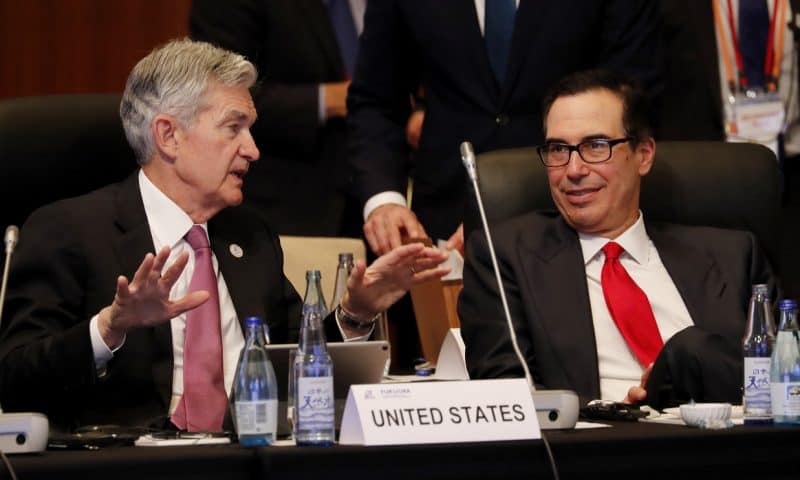Fed, Treasury vow to keep up support for economy as U.S. COVID-19 infections climb
U.S. stock-indexes finished higher Wednesday, as data showed a recovery in consumer confidence and higher home prices, helping to offset ongoing concerns about the rising number of new coronavirus cases in many American states.
Both the Dow and S&P 500 index booked their best quarterly performance in more than 20 years, while the Nasdaq Composite had its best quarter since 1999, as the indexes recovered from the lows seen in late March when the coronavirus crisis forced business activity to grind to a halt.
The stock market will be closed on Friday in observance of the Fourth of July holiday.
How did benchmarks perform?
The Dow Jones Industrial Average DJIA, +0.84% gained 217.08, or 0.9%, to settle at 25,812.88, those for the S&P 500 index SPX, +1.54% rose 47.05 points, or 1.5%, to close at 3,100.29, while the Nasdaq Composite Index COMP, +1.87% added 184.61 points, or 1.9%, to end at 10,058.77, its second highest close ever.
On Monday, the Dow gained 580.25 points, or 2.3%, its best one-day percentage climb since June 5, according to Dow Jones Market Data. The S&P 500 index advanced 44.19 points, or 1.5%, to finish at 3,053.24. The technology-laden Nasdaq Composite Index picked up 116.93 points, or 1.2%, to end at 9,874.15.
What drove the market?
Stocks rallied after testimony to Congress by Federal Reserve Chairman Jerome Powell and U.S. Treasury Secretary Steven Mnuchin underscored an ongoing commitment to anchor the U.S. economy through the global public health disaster.
Mnuchin said the Treasury and Fed were looking at extending the Fed’s established 11 emergency lending facilities to include asset-based lending markets, but also reiterated that additional types of COVID-19 aid likely will need to be addressed by Congress under the next phase of stimulus.
Powell emphasized that the ‘overriding goal’ of the central bank’s facilities is to help get the roughly 25 million workers who lost jobs during the pandemic back to work, while also warning that a second wave of COVID-19 infections could undermine consumer confidence again.
“While this bounce back in economic activity is welcome, it also presents new challenges—notably, the need to keep the virus in check,” Powell said.
U.S. stock-indexes finished higher Wednesday, as data showed a recovery in consumer confidence and higher home prices, helping to offset ongoing concerns about the rising number of new coronavirus cases in many American states.
Both the Dow and S&P 500 index booked their best quarterly performance in more than 20 years, while the Nasdaq Composite had its best quarter since 1999, as the indexes recovered from the lows seen in late March when the coronavirus crisis forced business activity to grind to a halt.
The stock market will be closed on Friday in observance of the Fourth of July holiday.
How did benchmarks perform?
The Dow Jones Industrial Average DJIA, +0.84% gained 217.08, or 0.9%, to settle at 25,812.88, those for the S&P 500 index SPX, +1.54% rose 47.05 points, or 1.5%, to close at 3,100.29, while the Nasdaq Composite Index COMP, +1.87% added 184.61 points, or 1.9%, to end at 10,058.77, its second highest close ever.
On Monday, the Dow gained 580.25 points, or 2.3%, its best one-day percentage climb since June 5, according to Dow Jones Market Data. The S&P 500 index advanced 44.19 points, or 1.5%, to finish at 3,053.24. The technology-laden Nasdaq Composite Index picked up 116.93 points, or 1.2%, to end at 9,874.15.
What drove the market?
Stocks rallied after testimony to Congress by Federal Reserve Chairman Jerome Powell and U.S. Treasury Secretary Steven Mnuchin underscored an ongoing commitment to anchor the U.S. economy through the global public health disaster.
Mnuchin said the Treasury and Fed were looking at extending the Fed’s established 11 emergency lending facilities to include asset-based lending markets, but also reiterated that additional types of COVID-19 aid likely will need to be addressed by Congress under the next phase of stimulus.
Powell emphasized that the ‘overriding goal’ of the central bank’s facilities is to help get the roughly 25 million workers who lost jobs during the pandemic back to work, while also warning that a second wave of COVID-19 infections could undermine consumer confidence again.
“While this bounce back in economic activity is welcome, it also presents new challenges—notably, the need to keep the virus in check,” Powell said.

